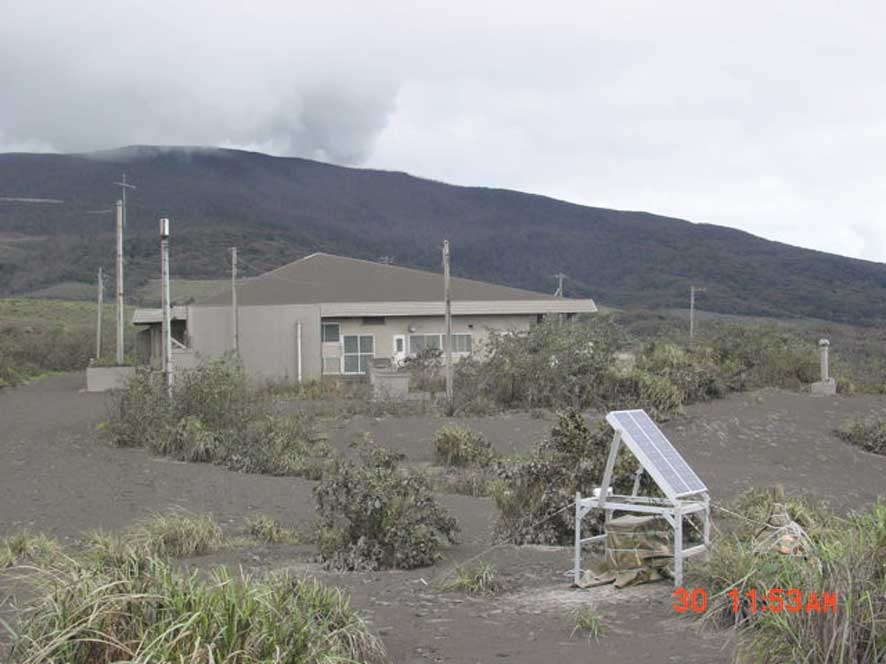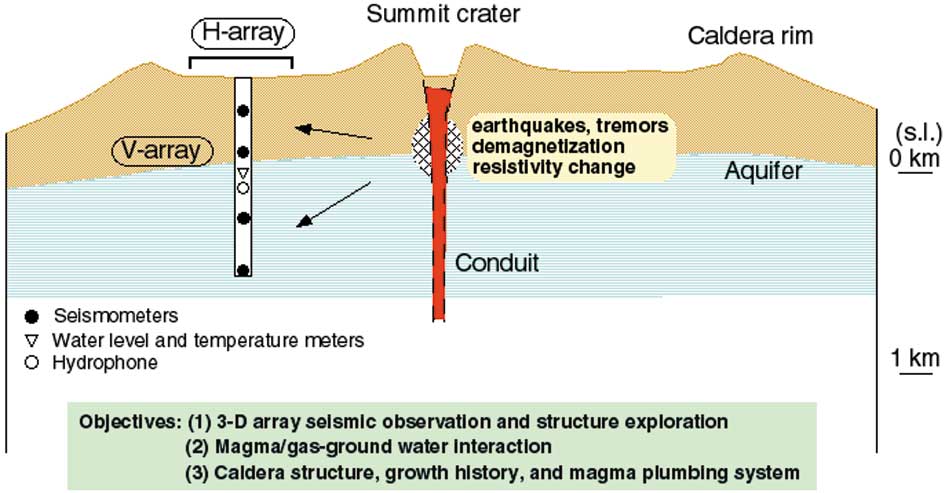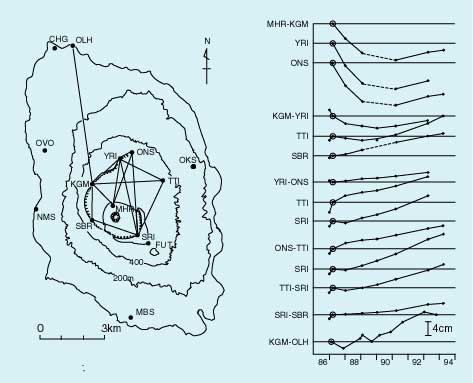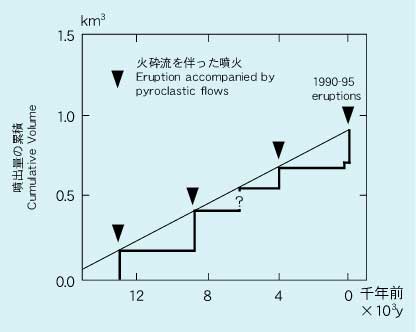Top Next
5-2.Researches to Predict Volcano Eruptions
Intense, modern monitoring of volcanoes has brought advances in volcanology,
allowing some precursors to be identified prior to eruptions. However,
precise prediction of eruption still cannot be achieved scientifically.
The following researches are being carried out to understand volcanic processes
and magma supply systems under volcanoes.
5-2-1. Joint Experiment on Volcano Structure
and Magma Supply System
Since 1994, joint experiments have been conducted in several volcanoes
in Japan to reveal the structure and magma supply system by a group of
scientists from national universities under the National Research Project
for Prediction of Volcanic Eruptions. Anomalous zones were found beneath
some volcanoes by electromagnetic surveys and seismic exploration experiments
(see, 6-8 Joint experiment on volcano structure). At Izu-Oshima volcano,
we could detect magma bodies at depths of 5 and 8-10km beneath the caldera
with a new technique of seismic waveform tomography (see, 8-8 Volcano Research
Center).
5-2-2. Observations with ARGOS System and Drilling
Project in a Caldera
We have developed the telemetry system using ARGOS satellite to obtain
safely precise data of geomagnetic field and fumarolic temperature variations
from the area closest to active craters. We deployed the ARGOS geomagnetic
observation system at the southwestern slope of Miyakejima volcano just
after the eruption on August 29, 2000, to detect geomagnetic total force
variations caused by temperature change beneath the summit crater (Fig.1)
(see, 7-3 Miyakejima eruption). To detect small changes associated with
the ascent of magma and volcanic gas, a 1km-deep hole was drilled within
the summit caldera of Izu-Oshima volcano. Since 1999, we have started a
3D-array observation by installing seismometers, a hydrophone and an electrical
conductivity-temperature meter in it (Fig.2). Borehole geophysical measurements
and analysis of rock samples collected during drilling yielded a new insight
into the structure and origin of the caldera and the eruption history of
the volcano.
5-2-3. Researches on Mid- to Long-term Predictions
In Izu-Oshima, which recently erupted every several tens of years,
a continuous inflation of the volcanic body, indicating the steady storing
of magma at a depth of 6 to 9km, has been detected by repeated EDM and
GPS observations (Fig.3). We also detected a continuous inflation of Miyakejima
volcano before the beginning of its activity on June 26, 2000 (see, 7-3
Miyakejima eruption). Even without any historic eruption records, a geological
analysis of the volcano can sufficiently help us with long-term predictions
of eruptions (Fig.4). As the modes of eruption may reflect magma compositions,
analyzing products erupted in the earlier stage is also important to know
the mode of successive eruptions.

Fig.1. ARGOS geomagnetic observation system at Miyakejima volcano.

Fig.2. Scientific drilling within the caldera of Izu-Oshima volcano.
5-2-3. Researches on Mid- to Long-term Predictions
In Izu-Oshima, which recently erupted every several tens of years,
a continuous inflation of the volcanic body, indicating the steady storing
of magma at a depth of 6 to 9km, has been detected by repeated EDM and
GPS observations (Fig.3). We also detected a continuous inflation of Miyakejima
volcano before the beginning of its activity on June 26, 2000 (see, 7-3
Miyakejima eruption). Even without any historic eruption records, a geological
analysis of the volcano can sufficiently help us with long-term predictions
of eruptions (Fig.4). As the modes of eruption may reflect magma compositions,
analyzing products erupted in the earlier stage is also important to know
the mode of successive eruptions.

Fig.3. Distance changes of base lines across the caldera and northern
slope after the 1986 eruption of Izu-Oshima volcano.

Fig.4. Cumulative volume-time diagram for eruption products at Fugen-dake
in Unzen
Top Next



